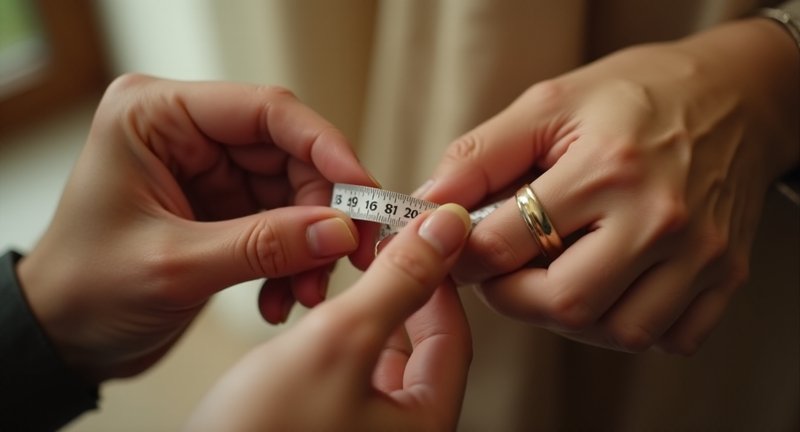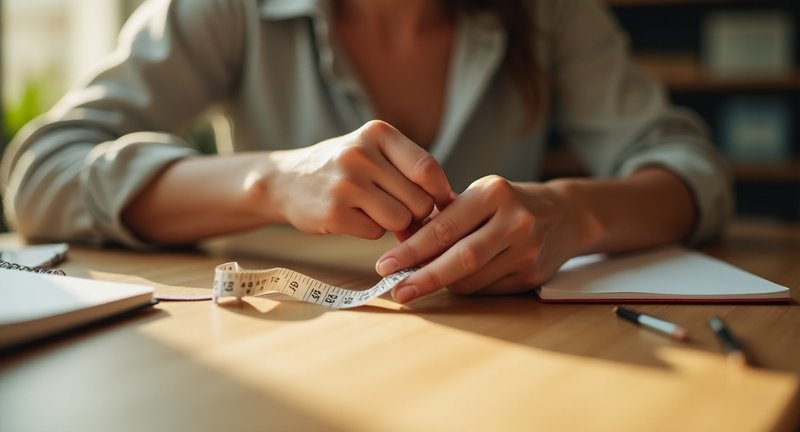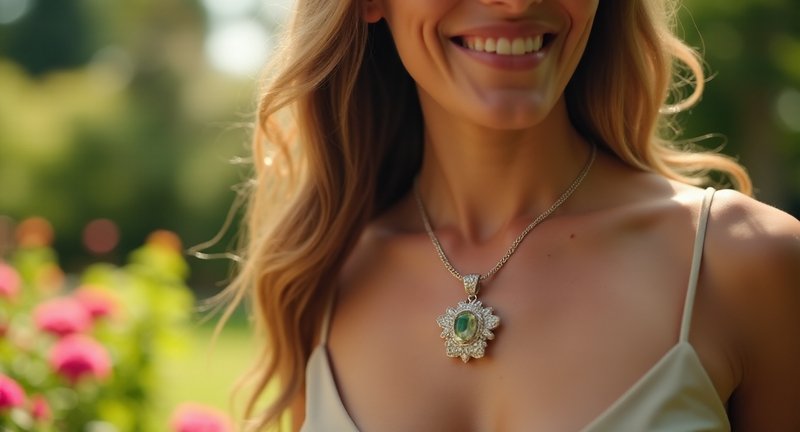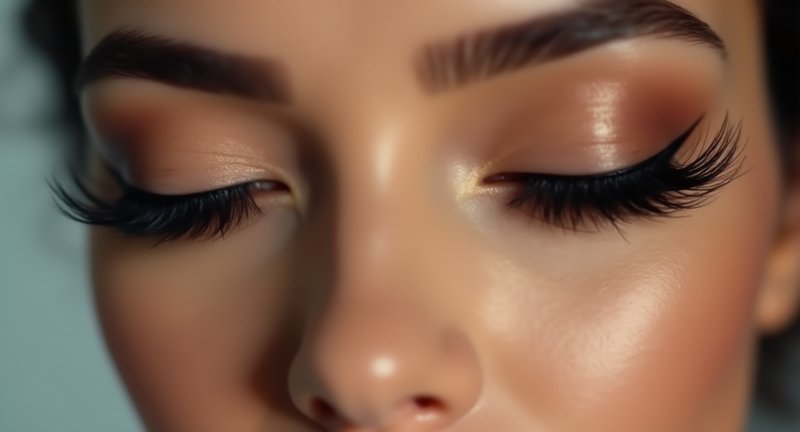How to Measure Ring Size in Centimeters
Sizing your finger for a ring can feel like an intricate dance, but trust me, it’s easier than you think. When learning how to measure ring size in centimeters, it’s all about the right tools and technique. Don’t worry, I’ve been through this process countless times, and it never gets old!
First, grab a piece of string or even a ribbon, something soft that wraps snugly around your finger. Place it where you’d normally wear the ring there’s a secret here: don’t pull too tight! Once you’ve wrapped it comfortably, mark the point where the string overlaps.
Now comes the fun part. Lay your string flat and measure the length with a ruler, and voila! You’ve got the circumference of your finger in centimeters. This is how to find your ring size in cm the easy way.

If you’re aiming for perfection, do this a few times fingers tend to fluctuate in size based on temperature or time of day. My personal tip? Measure when your fingers are neither too cold nor too warm to get the most accurate reading.
Once you’ve got your circumference, it’s time to compare it to a sizing chart. This step is crucial, as slight variations can make all the difference between a ring that fits like a glove or one that gets stuck halfway. Trust me, you’ll thank yourself later!
How to Measure Ring Size in Centimeters. A Fresh Perspective
When it comes to figuring out your ring size, things can get a bit tricky especially if you’re looking for that perfect fit and don’t want to rely on guessing. From my personal experience, using a flexible measuring tape is one of the simplest methods. It’s precise, straightforward, and surprisingly easy. Let’s break it down.
What You’ll Need:
- A flexible measuring tape (tailor’s tape works best)
- A pen or pencil
- A small strip of paper (if you don’t have a tape)
- A ruler (just in case)
The Method:
-
Wrap the Tape Around Your Finger: Simply wrap the measuring tape around the base of your finger. Not too tight, but snug enough to give you an accurate read. Mark where the tape meets the starting point. Remember to measure the widest part of your finger it could be near the knuckle!
-
Use a Paper Strip: Don’t have a flexible tape? No problem. Take a strip of paper, wrap it around your finger, and mark where the paper overlaps. Then, lay the paper flat and measure the length with a ruler.
-
Check Against a Size Chart: Once you’ve got your measurement, compare it to a ring size chart. You can easily find one online. Here’s a tip: be mindful of how temperature affects your hands. Measure your finger at the end of the day when it’s naturally a bit warmer and likely more accurate.
By taking this approach, you’re more likely to get the perfect fit. And hey, who knew something as simple as a strip of paper could lead you to a perfectly sized ring?

Understanding Ring Size and Its Importance
As it relates to choosing the perfect ring, size matters more than you’d think. A ring that’s too tight feels like it’s squeezing your soul, while one too loose might slip away, just like lost opportunities. Trust me, getting the size right is a game-changer.
From my experience, finding the right size is about more than just numbers. The comfort, the way it hugs your finger, all contribute to how it feels when worn. It’s not just a piece of jewelry; it’s an extension of your personality.
And here’s something I’ve noticed over the years our fingers aren’t always the same size. They can fluctuate based on weather, time of day, or even mood. Sounds crazy, but it’s true. A morning fit might not feel the same by nightfall.
To ensure the best fit, I always recommend trying on rings in different conditions. What feels right in the heat of summer may feel too snug in the cool of winter. And don’t forget, the width of the band makes a difference too wider bands often require a larger size.
As a matter of fact, it’s not just about aesthetics. The right size means you can wear your ring comfortably for years, without needing constant adjustments. It’s all about balancing the perfect fit with style, and once you nail it, you’ll feel like the ring was made just for you.
Tools Needed for Measuring Ring Size
Regarding finding the perfect ring size, I’ve learned that having the right tools makes all the difference. There’s nothing worse than realizing your new ring is too snug or, even worse, slips right off. So, let’s talk about the essentials I always keep on hand.
A flexible tape measure is the first thing I reach for. Not just any tape measure, though a fabric or tailor’s one works best since it easily wraps around your finger. It’s soft, bends perfectly, and gives you an accurate reading.
Next up, a ring sizer gauge is invaluable. This little tool looks like a bunch of plastic rings on a keychain, each marked with different sizes. I’ll admit, I use it often when I’m helping friends with their jewelry purchases. It’s a lifesaver for those who want a more direct way to check.
For those of you more into digital options, a caliper is another tool I’ve come to appreciate. It measures the diameter of the ring or your finger with precision. It’s sleek, modern, and perfect if you’re into exact measurements.
And, don’t overlook something as simple as a strip of paper or a thin piece of string. Wrap it around your finger, mark where it overlaps, and then measure that length. It’s the method I started with before upgrading to all these nifty tools.
Whatever tool you choose, just remember that finger size can change depending on time of day, temperature, or even hydration levels. So, it’s worth double-checking when you feel your fingers are at their most natural.
The Basics of Ring Sizing
As it relates to ring sizing, it’s not just about fitting your finger it’s about comfort, style, and getting the perfect fit. Over the years, I’ve discovered that understanding ring sizes is like discovering the secret to personalized jewelry.
First things first: the size of your ring finger fluctuates. Yes, that’s right. Heat, cold, even how much salt you had for dinner can affect the fit. So, make sure to take your measurements when your hands are at a comfortable temperature, not swollen from a workout or shivering from the cold.
Here are some key things to keep in mind:
-
Comfort is king: Your ring should glide over your knuckle with minimal resistance but not feel loose. If you find yourself twisting it around too much, it might be time to reconsider the size.
-
The knuckle test: Slide the ring over your knuckle. If it’s snug but doesn’t leave a red mark or feel like it’s squeezing the life out of your finger, you’re on the right track.
-
Sizing tools: There are plenty of ways to measure, from using a simple strip of paper to more precise metal ring sizers that jewelers use. Personally, I’ve always found the latter to give the most accurate results, but hey, a piece of string can do the trick in a pinch too.
And here’s a fun fact: your dominant hand’s fingers are often slightly larger than those on your non-dominant hand. So, don’t assume your ring size will be the same on both hands!
Remember, it’s not just about the numbers it’s about the experience of wearing a ring that feels like it was made for you.
Using a Ring Sizer for Accurate Measurements
Using a ring sizer is a delightful journey into the world of precise adornment. Imagine the satisfaction of slipping on a ring that feels like it was made just for you, a perfect fit that dances gracefully on your finger.
I remember my first experience with a ring sizer, eagerly unfolding the plastic tool like a treasure map. The thrill of anticipation surged as I prepared to find my perfect size, a feeling that felt almost ceremonial.
Simply wrap the sizer around your finger, and let it whisper the secrets of your size. It’s fascinating how a seemingly mundane measurement can unlock a world of style and elegance.
One tip I learned along the way is to measure your finger at different times of the day. Our fingers can be fickle, swelling slightly in the heat of the day or shrinking in the chill of evening. You wouldn’t want your new ring to feel like a vice grip, now would you?
Also, consider the width of the band you’re eyeing. Wider bands can feel snugger than their delicate counterparts, so adjusting your measurement is crucial. It’s a bit like choosing the right pair of shoes comfort should always be a priority.
As a matter of fact, when you’ve found your magic number, jot it down. Trust me, when you’re lost in the dazzling array of rings, having that size in your pocket can save you from confusion. So go ahead, grab that ring sizer, and embark on your fitting adventure. Your perfect ring awaits!
Measuring Ring Size with a String or Paper Strip
Measuring your ring size with a humble string or paper strip can be an oddly satisfying task. It’s almost like embarking on a small adventure, where you’re the hero of your own jewelry quest.
First, you’ll want to grab a piece of string or a thin strip of paper anything that can wrap around your finger comfortably. As you gently wrap it around your chosen finger, make sure it feels snug but not restrictive. Picture it as a gentle hug for your digit, just firm enough to feel secure.
Once you’ve got that perfect fit, mark where the string or paper overlaps. This little mark is your treasure map, leading you to the next step. Straighten out your string or strip, and grab a ruler or tape measure to measure the length from the starting point to your mark.
Now, here’s the part where the magic happens. Depending on the measurement you’ve just obtained, you can refer to a ring size chart to find your exact size. It’s like finding a secret key to a treasure chest, except the treasure is a beautiful piece of jewelry waiting for you.
Remember, it’s always a good idea to measure at different times of the day. Our fingers can swell or shrink based on heat or activity. Just think of it as your fingers being a bit moody kind of like me before my morning coffee!
In the end, this simple method can save you from the frustration of ill-fitting rings. So, go on, embrace the string, and find that perfect size!
Converting Ring Size from Inches to Centimeters
With a focus on finding the perfect ring, I’ve often found myself in a mini math conundrum. You might be surprised to learn that converting ring sizes from inches to centimeters can feel like navigating a labyrinth one that leads directly to your ideal fit.
First, let’s unravel this mystery. An inch measures approximately 2.54 centimeters. It’s a simple equation, yet it’s the secret ingredient to achieving that snug embrace around your finger. If your ring size hovers around a certain number in inches, just multiply it by 2.54. Voila! You’ve unlocked the metric equivalent.
I remember the first time I faced this conversion. I was standing in a glitzy jewelry store, surrounded by sparkles that seemed to whisper my name. The salesperson asked for my size in centimeters, and panic set in. Thankfully, I had my trusty smartphone ready to save the day. A quick search and a few taps later, I was armed with the knowledge I needed.
It’s fascinating how a little math can lead to something so beautiful. I often share this tip with friends when they’re on a quest for the perfect engagement ring or a heartfelt gift. Just imagine the joy of presenting a ring that fits like it was crafted just for them.
So, whether you’re shopping for yourself or someone special, keep this conversion trick in your back pocket. You’ll be prepared to dazzle with not just the right style, but the right fit.
Common Mistakes When Measuring Ring Size
In the context of measuring ring size, I’ve seen folks stumble into some truly avoidable pitfalls. One common mistake is assuming their finger size is static. Our fingers can swell or shrink with temperature, time of day, or even our mood, so it’s crucial to measure at the right moment.
Another blunder is skipping the all-important step of trying on rings. Trust me, just eyeballing it won’t cut it. It’s like choosing a shoe size without trying them on nothing but a recipe for regret.
People often rely on those fancy online size charts, but here’s a secret: they’re not always accurate. If you want precision, nothing beats the old-fashioned method of “How to Measure Ring Size in Centimeters.” Grab a tape measure or a strip of paper and get to work!
One tip I swear by is measuring both at the base of the finger and at the knuckle. This gives you a better idea of how the ring will fit, especially if your fingers are a bit larger around the knuckle. It’s about finding that sweet spot for comfort.
And don’t forget the time factor! Measure your finger at different times of day. You might be surprised at how much it can change. A little patience goes a long way in ensuring that perfect fit.
So, remember, take your time, try rings on if you can, and use reliable methods. Happy ring hunting!
How to Measure Ring Size Without a Professional
Considering determining your ring size without visiting a jeweler, I can tell you from experience that it’s both an art and a science. It might feel a bit like a treasure hunt, but measuring your finger at home can be surprisingly straightforward. Here’s how I navigate this shiny journey:
-
Gather Your Tools:
- A piece of string or a strip of paper (ideally thin).
- A ruler or a measuring tape.
- Scissors (just in case you need to trim things down).
- A pen to jot down your measurements.
-
The Wrapping Technique:
- Take your string or paper and wrap it around the base of the finger you plan to adorn.
- Make sure it’s snug but not too tight think of it as a gentle hug, not a constricting squeeze.
- Mark where the ends meet. This is your golden point.
-
Measure the Length:
- Lay the string or paper flat and measure the length in millimeters using your ruler. This number represents your finger’s circumference.
-
Find the Size:
- Now comes the fun part! Use a ring size chart available online to translate that measurement into a ring size. If you’ve got a favorite ring, you can also measure its inner diameter as a reference.
-
Consider the Weather:
- Fingers can swell in the heat and shrink in the cold. Keep this in mind, especially if you’re measuring on a particularly warm or chilly day.
Trust me, with a little patience and precision, you’ll unearth the perfect size for your next ring adventure.
How to Measure Ring Size in Centimeters
Concerning finding that perfect ring, precision is key. I remember the first time I tried to gauge my ring size it felt like deciphering a secret code! But fear not, measuring your ring size can be as straightforward as pie, especially when you break it down into manageable steps.

Here’s how I approach it:
-
Gather Your Materials:
- A flexible measuring tape (like the ones used in sewing)
- A ruler, if you prefer measuring in centimeters
- A piece of string or paper strip, if you don’t have a tape handy
-
The Wrapping Technique:
- Wrap the measuring tape or string around the base of your finger where the ring will sit.
- Ensure it’s snug but not too tight you want to avoid the dreaded sausage finger look!
- Mark the point where the tape or string overlaps.
-
Measure Your Success:
- If using string, lay it flat against a ruler to get the measurement in centimeters.
- If using a tape, simply read off the number directly.
-
Consult the Size Chart:
- Use the measurement to check against a ring size chart (easily found online) that translates centimeters to standard ring sizes.
- Remember, different brands may have slight variations, so it’s always wise to check the specific sizing guide.
-
Double-Check:
- Just for good measure, I always recommend repeating the process a couple of times. This way, you can be confident in your findings.
Remember, sizing can change with temperature and time of day, so choose a moment when your fingers are at their average size. With these simple steps, you’ll be well on your way to rocking that dazzling piece of jewelry in no time!
Determining Ring Size Based on Finger Width
Considering finding the perfect ring, understanding your finger width can be the key to unlocking a world of comfort and style. Over the years, I’ve learned that a snug fit can elevate the overall aesthetic and feel of a ring, transforming it from a mere accessory into a statement piece. Here’s a little guide based on my experiences to help you navigate this colorful journey.
Steps to Determine Ring Size Using Finger Width
-
Gather Your Tools: You’ll need a ruler or a flexible measuring tape.
-
Measure Your Finger:
- Choose the finger where the ring will reside. Different fingers have varying widths.
- Gently wrap the tape or ruler around the widest part of your finger.
- Note the measurement in millimeters (mm) for precision.
-
Assess Width Differences:
- Take into account that fingers can fluctuate in size throughout the day due to temperature, hydration, and activity levels.
- A warm day can cause your fingers to expand, while the chill of winter might contract them.
-
Consult a Ring Size Chart:
- With your measurement in hand, compare it to a ring size chart. This will correlate your finger width with a corresponding size.
-
Consider Comfort and Style:
- Opt for a slightly larger size if you prefer a relaxed fit, especially for wider bands. A good rule of thumb is to allow a little wiggle room without compromising security.
By considering your finger width in this delightful process, you’ll not only find a ring that fits but one that feels like it was made just for you. Enjoy the hunt; it’s part of the magic!
The Impact of Temperature on Ring Size
With regard to the delicate art of ring sizing, temperature plays a surprisingly pivotal role. You might not think twice about it, but our bodies react to warmth and chill in ways that can impact how a ring fits on our fingers.
I recall a summer day when I slipped on a new ring, feeling the metal wrap snugly around my finger. The heat swelled my digits, causing that once-perfect fit to morph into an uncomfortable squeeze. It was a clear reminder that temperature can transform our jewelry experience into a bit of a rollercoaster.
On the flip side, a chilly winter evening found me wrestling with the same ring, now sliding off my finger like a mischievous sprite. The cold constricted my fingers, making that lovely band feel like a slippery ghost. I learned that the perfect fit isn’t just about measurements; it’s about the environment too.
As I began to pay closer attention, I realized that fluctuations in temperature could shift our perception of comfort. If you’re trying on rings in a warm shop, they may feel tighter than they will when you step outside into the brisk air.
So, whether you’re buying a piece for yourself or a loved one, consider the climate. A bit of heat or cold can make all the difference. Your dream ring might just be waiting for the right moment to reveal its true fit.
Measuring Ring Size for Different Finger Types
When dealing with finding that perfect ring size, it’s essential to consider the unique characteristics of different fingers. Trust me, not all fingers are created equal!
For instance, the ring finger usually has a slightly larger circumference than the index finger. I’ve discovered that knowing this can save you from those awkward moments when your beautifully crafted ring just won’t slide on.
Let’s not forget about the little fingers; they tend to be petite and delicate. I often recommend trying on various rings at jewelry stores, especially if you’re unsure. It’s an enjoyable experience that can lead to delightful discoveries!
Speaking of delightful, I’ve noticed that my dominant hand tends to have slightly larger fingers. This is a fun quirk of anatomy that can really throw off your measurements. So, when picking a size, consider trying rings on both hands to find that sweet spot.
And then there are those adventurous souls who love to wear statement pieces on multiple fingers. If you’re one of them, ensure you measure each finger individually. After all, a ring meant to dazzle should fit like a glove!
In my journey of ring sizing, I’ve learned that the best method is to simply embrace the quirks of your hands. Measure them with a soft tape or even a piece of string. This intimate process not only helps in achieving the perfect fit but also adds a personal touch to your jewelry collection.
So, as you embark on your ring-sizing adventure, remember to celebrate the uniqueness of your fingers and find joy in the process!
How to Measure Ring Size for Women vs. Men
In relation to measuring ring sizes, there’s a subtle art that varies between the ladies and the gentlemen. From my adventures in the jewelry world, I’ve found that understanding these differences can make all the difference.
For women, the process often feels like a delicate dance. Ladies tend to prefer rings that fit snugly on their fingers, allowing for comfort without a hint of constriction. It’s fascinating how a ring’s fit can affect not only its appearance but also the wearer’s confidence.
On the flip side, men’s rings typically embrace a more robust style. When I’ve helped my male friends choose their bands, the fit often reflects their personality bold, confident, and sometimes adventurous. A looser fit can be ideal here, especially for rings that feature intricate designs or heavier materials.
One of the quirks I’ve discovered is that temperature can affect finger size. You might find that on a warm day, your fingers swell slightly, while they might shrink in cooler temperatures. This little detail is crucial, especially when you’re picking a ring for someone special.
To gauge the right fit, using a soft measuring tape can be incredibly effective. If you don’t have one handy, a strip of paper can also work wonders. Just wrap it around the finger in question, mark where it overlaps, and voila! You’re on your way to finding the perfect fit.
So, whether you’re treating yourself or planning a surprise, take your time measuring. After all, the right ring size can turn a thoughtful gesture into a cherished memory.
Knowledge Base
What size ring is 7 cm?
A ring with a 7 cm circumference corresponds to approximately a US size 13.5. This measurement is usually taken around the base of the finger or at the knuckle. Keep in mind that ring sizes may slightly differ between manufacturers, so it’s important to try the ring on or use a precise sizing tool. Additionally, factors like finger shape and swelling throughout the day can affect comfort, so opting for a slightly adjustable ring size is advisable.
What is my ring size 2.5 inches?
A 2.5-inch ring circumference converts to about 63.5 mm. In the US ring sizing chart, this would be approximately a size 10.5. However, this is a rough estimate, and exact sizing depends on whether you’re measuring at the base or the knuckle of your finger. It’s always helpful to try multiple sizes or use a ring-sizing guide to ensure accuracy, as even a small difference in circumference can change the fit of the ring significantly.
How to discreetly measure ring size?
To discreetly measure ring size, try borrowing a ring the person already wears and trace the inner circumference onto a piece of paper. Alternatively, you can press the ring into a soft material like clay or soap to create an impression, which can be used to measure the diameter later. Another method is to wrap a string or strip of paper around their finger while they’re distracted and later measure the length of the string or paper to get their ring size.
How to size a ring without a ring sizer?
Without a ring sizer, you can use a piece of string, dental floss, or a thin strip of paper to wrap around the base of your finger. Mark where the string or paper meets, then measure the length with a ruler. Compare this measurement to an online ring size chart to find the corresponding size. You can also measure a ring that fits well and check the diameter against a chart to estimate your ring size.
How to calculate ring size in cm?
To calculate ring size in centimeters, you need to measure the circumference of your finger where the ring will sit. Wrap a string, paper strip, or tape around the finger, mark the point where the ends meet, and then lay it flat against a ruler to measure the length in centimeters. Compare this length to a ring size chart to determine the closest size. Some charts convert the circumference directly to US, UK, or European sizes.
What is a 6 cm ring size in the US?
A ring with a 6 cm (60 mm) circumference corresponds to approximately a US size 9.5. This size may vary slightly depending on the ring’s design and the shape of your finger, but 60 mm is typically classified as a size 9.5 in US sizing charts. Always consider factors like swelling or knuckle width when selecting a ring size for optimal comfort.
What ring size is 5.8 cm?
A 5.8 cm ring circumference converts to approximately a US size 8.5. This measurement is important because a slightly smaller or larger size can make a big difference in comfort and wearability. Ensure that you measure both the base of your finger and the knuckle, as the widest part of the finger will determine how easy it is to slip the ring on and off.
What ring size is 2 cm?
A ring with a 2 cm (20 mm) diameter is about a US size 10. This is calculated by measuring across the widest part of the ring’s inner circle. The diameter is crucial for ensuring a snug but comfortable fit, especially for rings made of materials like metal that can’t be easily resized. Always compare the diameter to an accurate ring size chart for confirmation.
How can I measure my ring size in inches at home?
To measure your ring size in inches at home, wrap a string or thin strip of paper around your finger, marking the point where the ends meet. Then, lay the string flat and measure its length in inches. Convert the measurement to a ring size using an online chart. For a more accurate result, you can also measure a ring that already fits you well by determining its diameter in inches and comparing it to a sizing chart.
How big is a size 16 ring?
A size 16 ring is considerably large and typically measures around 24.6 mm in diameter. This size is more commonly found in men’s rings, particularly for individuals with larger fingers. It’s important to measure your finger accurately when looking for a ring of this size, as rings this large can be difficult to resize and need to fit comfortably over both the knuckle and the base of the finger.
What is a 48 ring size in CM?
A size 48 ring has a circumference of approximately 4.8 cm, or 48 mm. This size is most common in European ring sizing systems, which measure the inner circumference. To convert this to a US size, it’s about a size 4.5. European sizes are often used in jewelry from countries like France and Germany, so it’s important to know the conversion if purchasing a ring internationally.
What size is a ring with a diameter of 1.7 cm?
A ring with a 1.7 cm diameter corresponds to approximately a US size 6. The diameter measurement is crucial because it ensures that the ring will comfortably fit around your finger. This size is relatively standard and often falls within the range of women’s rings. Always double-check measurements against a ring sizing chart for accuracy, as small differences in diameter can lead to an incorrect fit.











I never thought I’d say this, but measuring my ring size with a piece of string turned into a surprisingly fun ritual! The way you described it here totally hit home like I was on some mini quest to unlock the ultimate jewelry prize. Honestly, it adds a whole new level of excitement to something that’s usually just a quick step before buying a ring. I also loved the tip about checking finger size at different times of day totally true! The mood swing comparison made me laugh because my fingers seem to be just as fickle as I am before my morning coffee too! Now I feel more confident about measuring the right size and avoiding the hassle of a poorly fitting ring. Thanks for making something so simple feel like an adventure I can actually enjoy. Next time, I’m bringing out the string and treating it like a full-blown treasure hunt!
Ahh, I love how you describe using a ring sizer! It really does feel like an adventure, doesn’t it? My first time using one, I felt so fancy and ‘official,’ like I was diving into the world of professional jewelry buyers or something. And you’re so right about measuring at different times of the day. I once made the mistake of sizing my finger right after a long, hot day, and the next morning, my ring felt way too big. It’s definitely something to keep in mind.
I couldn’t have said it better! The fluctuating ring size thing was such a revelation to me when I first started looking into it. I mean, who knew that something as simple as the weather or eating a salty snack could make such a difference? I learned that lesson the hard way when I bought a ring that fit perfectly in the store, only to find it tight a few days later. Now I always take a few measurements throughout the day, and it’s made such a difference in getting a comfortable fit.
Oh wow, I totally agree about the flexible tape measure! I always used to think it was just something tailors used, but after trying it for ring sizing, it’s a game changer. I had a similar moment where I bought a ring online, only to have it slide right off because I guessed the size. Such a nightmare! Now, I make sure to use a fabric tape, and it’s been so much better. I haven’t tried the caliper yet, but the idea of getting a super precise digital measurement definitely piqued my interest! And you’re so right about the simple string method – it’s like a DIY hack when you don’t have tools around. Finger size changes? That caught me off guard the first time too. I’ll definitely remember to double-check when my hands feel ‘normal.’ Great advice!
Absolutely nailed it with the point about how a ring feels more like an extension of your personality than just jewelry. I’ve always thought that the way a ring fits has so much to do with how comfortable and confident you feel wearing it. The fluctuation in finger size is real I’ve experienced it firsthand, and it can really catch you off guard! Your advice on trying rings in different conditions is gold. It’s easy to forget how much the weather or even your mood can affect fit. And yes, wider bands needing a bigger size totally agree. When I got my first wider band ring, I was so confused why it didn’t fit the same as my other rings. Definitely a lesson learned!
Wow, I never thought to use a paper strip before! Such a handy tip if you don’t have a measuring tape lying around. It’s like having a backup plan. Personally, I always use the flexible measuring tape, and it’s been a game-changer for me. I love how easy it is to just wrap it around and get a quick, accurate read. And you’re spot on about measuring the widest part of the finger it took me a while to figure that out, and it definitely makes a difference. It’s amazing how something so simple can make sure the ring fits just right!
I totally agree! Measuring your finger can feel like a chore at first, but once you get the hang of it, it becomes almost second nature. I love how you mentioned using a string or ribbon – that method has saved me more times than I can count! And you’re absolutely right about the temperature tip. I made the mistake of measuring when my hands were cold once, and the ring ended up being too tight. Also, doing it a couple of times to ensure accuracy is a solid tip! It’s crazy how much our fingers can change depending on the day or weather. I’ve even had days where a ring that fit perfectly yesterday suddenly feels tight or loose today. The sizing chart comparison is a must too – it’s such a small step but makes a huge difference. Honestly, with all these little tricks, sizing a ring can actually become a fun little DIY project!